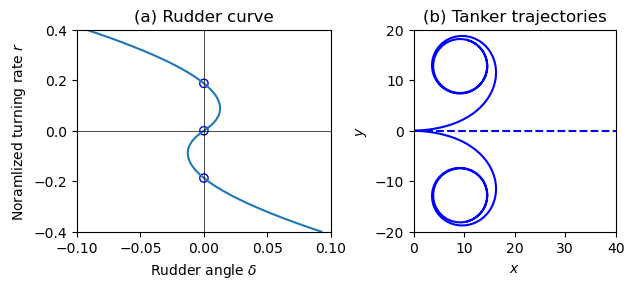Difference between revisions of "Figure 5.12: Stability analysis for a tanker"
Jump to navigation
Jump to search
| Line 110: | Line 110: | ||
# Save the figure | # Save the figure | ||
| − | plt.savefig("figure-5 | + | plt.savefig("figure-5-12-tanker_stability.png", bbox_inches='tight') |
</nowiki> | </nowiki> | ||
Revision as of 03:22, 17 November 2024
| Chapter | Dynamic Behavior |
|---|---|
| Figure number | 5.12 |
| Figure title | Stability analysis for a tanker |
| GitHub URL | https://github.com/murrayrm/fbs2e-python/blob/main/example-5.8-tanker stabilty.py |
| Requires | python-control, python-control |
Figure 5.12: Stability analysis for a tanker. The rudder characteristics are shown in (a), where the equilibrium points are marked by circles, and the tanker trajectories are shown in (b).
# example-5.8-tanker_stability.py - Stability of a tanker
# RMM, 29 Aug 2021
#
# Figure 3.15: Stability analysis for a tanker. The rudder characteristics
# are shown in (a), where the equilibrium points are marked by circles, and
# the tanker trajec- tories are shown in (b).
import control as ct
import numpy as np
import matplotlib.pyplot as plt
ct.use_fbs_defaults()
#
# System dynamics
#
def tanker_dynamics(
t, x, u, a1=-0.6, a2=-0.3, a3=-5, a4=-2, alpha=-2, b1=0.1, b2=-0.8):
v, r = x[0], x[1] # velocity and turning rate
delta = u[0] # rudder angle
return [
a1 * v + a2 * r + alpha * v * abs(v) + b1 * delta,
a3 * v + a4 * r + b2 * delta
]
tanker_model = ct.nlsys(
tanker_dynamics, None, inputs='delta', states=['v', 'r'])
print(tanker_model)
# Set up the plotting grid to match the layout in the book
fig = plt.figure(constrained_layout=True)
gs = fig.add_gridspec(2, 2)
#
# (a) Rudder curve
#
ax = fig.add_subplot(gs[0, 0]) # first row, first column
# Compute the input for each turning rate
rvec = np.linspace(-0.4, 0.4, 50)
delta_list = []
for r in rvec:
# Solve for the different equilibrium solutions
eqpt = ct.find_operating_point(
tanker_model, [0, 0], 0,
y0=[0, r], iy=[1], # Look for the desired turning rate
)
delta_list.append(eqpt.inputs[0])
dvec = np.array(delta_list)
ax.plot(dvec, rvec)
# Add the equilibrium points at zero
for x0 in [[0.1, 0.1], [0, 0], [-0.1, -0.1]]:
eqpt = ct.find_operating_point(tanker_model, x0, 0)
ax.scatter(
eqpt.inputs[0], eqpt.outputs[1], facecolors='none', edgecolors='b')
# Add labels and axis lines
ax.set_title("(a) Rudder curve")
ax.set_xlabel(r"Rudder angle $\delta$")
ax.set_ylabel(r"Noramlized turning rate $r$")
ax.plot([-0.1, 0.1], [0, 0], 'k', linewidth=0.5)
ax.plot([0, 0], [-0.4, 0.4], 'k', linewidth=0.5)
ax.axis([-0.1, 0.1, -0.4, 0.4])
#
# (b) Tanker trajectories
#
from math import sin, cos
ax = fig.add_subplot(gs[0, 1]) # first row, second column
# Create a full tanker model, including position and orientation
def full_tanker_dynamics(t, x, u, **params):
vdot, rdot = tanker_dynamics(t, x[3:], u, **params)
theta, v, r = x[2], x[3], x[4]
return [
cos(theta) + v * sin(theta), -sin(theta) + v * cos(theta),
r, vdot, rdot]
full_tanker_model = ct.nlsys(
full_tanker_dynamics, None, inputs='delta',
states=['x', 'y', 'theta', 'v', 'r'])
# Create simulations and plot them
timepts = np.linspace(0, 100, 100)
for r0, linestyle in zip([0.1, 0, -0.1], ['b-', 'b--', 'b-']):
response = ct.input_output_response(
full_tanker_model, timepts, 0, [0, 0, 0, 0, r0])
ax.plot(response.outputs[0], response.outputs[1], linestyle)
# Add labels and axis lines
ax.set_title("(b) Tanker trajectories")
ax.set_xlabel("$x$")
ax.set_ylabel("$y$")
ax.axis('scaled')
ax.axis([0, 40, -20, 20])
# Save the figure
plt.savefig("figure-5-12-tanker_stability.png", bbox_inches='tight')
